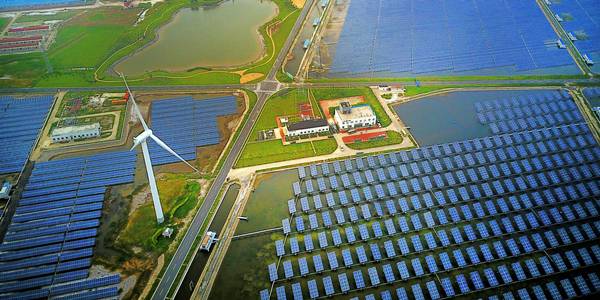
Global investment in renewable energy slipped 14% in the opening six months of 2019, as the world’s biggest market, China, moved away from government-set tariffs to auctions for new wind and solar power capacity, according to the latest figures from BloombergNEF (BNEF).
The 39% drop in spending in the Asian clean-energy powerhouse, at $28.8bn the lowest figure for any first half-year (1H) period since 2013, pulled down worldwide capital investment to $117.6bn, 14% lower than in 1H 2018.
But BNEF’s head of Asia-Pacific unit Justin Wu said though the slowdown in investment in China is “real”, the 1H 2019 numbers “probably overstate its severity”.
“We expect a nationwide solar auction happening now to lead to a rush of new PV project financings,” he stated. “We could also see several big deals in offshore wind in the second half.”
Read moreBNEF’s figures for clean energy investment in 1H 2019 show “mixed fortunes” for the world’s major markets, Wu noted, with the “big three” – China, the US and Europe – all showing falls, but with the US down a modest 6% at $23.6bn and Europe down 4% at $22.2bn compared to the same period 2018, far less than China’s 39% fall-back.
In Asia, spending rose in Japan, which attracted $8.7bn in new capital, up 3% on 1H 2018, and in India, where investment came in at $5.9bn, up 10%, as the country continued its drive to build 175GW of renewable energy capacity by 2022.
In Europe, Spain reeled in $3.7bn, up 235% on the same period a year earlier, and the UK was up 35%, at $2.5bn. But in the Netherlands investment was 41% lower that in 1H 2018, at $2.2bn, Germany was down 42% at $2.1bn, and France lower by 75% at $567m. Sweden saw investment jump 212% to $2.5bn, and the Ukraine was up 60% to $1.7bn.
Among other renewable energy investments in 1H 2019 highlighted by BNEF was the financing of a utility-scale project in Dubai – Saudi-based ACWA Power’s 950MW Mohammed bin Rashid Al Maktoum IV solar thermal and PV complex outside the megalopolis, which brought in $4.2bn in capital – and two offshore wind arrays in the sea off Taiwan – Wpd’s 640MW Yunlin Yunneng and Ørsted’s 900MW Greater Changhua, which together are expected to represent a $5.7bn spend.
Overall, 1H 2019 asset finance of utility-scale generation projects such as wind and solar farms was down 24% at $85.6bn, BNEF noted, “due in large part to the China factor”, while financing of small-scale solar systems of less than 1MW was up 32% at 3.7bn.
Read moreInvestment in specialist clean energy companies via public markets was 37% higher at $5.6bn – a figure boosted by two equity rounds for electric vehicle makers, an $863m secondary issue for Tesla, and a $650m convertible issue for China-based NIO.
Venture capital and private equity funding of clean energy companies in 1H 2019 was down 2% at $4.7bn, but BNEF spotlighted three “exceptionally large” deals that bucked the trend, the $1bn each for Swedish battery company Northvolt and US electric vehicle battery charging specialist Lucid Motors, and the $700m raised for another American EV player, Rivian Automotive.